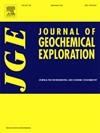基于黄铁矿微量元素和同位素特征的PbZn矿床机器学习分类——以Gunga矿床为例
IF 3.4
2区 地球科学
Q1 GEOCHEMISTRY & GEOPHYSICS
引用次数: 0
摘要
矿物黄铁矿通常与铅锌矿有关,可含有多种微量元素,并受温度、流体成分和金属来源等因素的影响。这些微量元素长期以来被用来区分不同类型的铅锌矿床。然而,传统的判别图通常依赖于二维或三维,无法全面捕捉黄铁矿微量元素与矿床类型之间的复杂关系。为了解决这一限制,本研究采用了随机森林(RF)、支持向量机(SVM)、梯度增强(GB)和多层感知器(MLP)四种机器学习算法来开发基于黄铁矿微量元素组成的分类模型。这些模型是在来自134个矿床或地层单元的5400个数据点的数据集上进行训练的,这些数据集含有来自公开来源的微量元素数据。分类器的性能通过使用leave-one-group out (LOGO)方法的变体进行交叉验证来评估。该研究将这些机器学习模型应用于lasbella - khuzdar成矿带Gunga铅锌矿床黄铁矿样品中最新获得的地球化学数据。结果表明,分类器能准确识别铅锌矿床来源,预测结果可靠。模型表明,Gunga矿床黄铁矿的地球化学特征来源于富集Pb、Zn、Sb、Tl、As和Ge的沉积-热液流体,与地质和地球化学证据一致。黄铁矿的原位δ34S值在−24‰~ +25‰之间,表明矿床中的硫主要来源于同时期的海水硫酸盐。此外,铅同位素组成指示了冈嘎矿床铅锌的地壳来源。综合分类器预测结果,结合硫、铅同位素分析,认为冈嘎铅锌矿床为典型的CD型矿床。这些发现突出了机器学习技术在矿床分类中的有效性,并为Gunga铅锌矿床的成因提供了新的见解。本文章由计算机程序翻译,如有差异,请以英文原文为准。
Machine learning-driven classification of PbZn ore deposits using pyrite trace elements and isotopic signatures: A case study of the Gunga deposit
The mineral pyrite, commonly associated with Pb![]() Zn deposits, can contain a variety of trace elements and is influenced by factors such as temperature, fluid composition, and metal source. These trace elements have long been used to differentiate between various types of Pb
Zn deposits, can contain a variety of trace elements and is influenced by factors such as temperature, fluid composition, and metal source. These trace elements have long been used to differentiate between various types of Pb![]() Zn deposits. However, traditional discriminant diagrams, which typically rely on two or three dimensions, fail to comprehensively capture the complex relationships between pyrite trace elements and deposit types. To address this limitation, this study employed four machine learning algorithms—random forest (RF), support vector machine (SVM), gradient boost (GB), and multilayer perceptron (MLP)—to develop classification models based on pyrite trace element compositions. The models were trained on a dataset of 5400 data points from 134 mineral deposits or stratigraphic units with trace element data from published sources. The performance of the classifiers was evaluated via cross-validation using a variant of the leave-one-group-out (LOGO) method. The study applied these machine learning models to newly obtained geochemical data from pyrite samples collected at the Gunga Pb
Zn deposits. However, traditional discriminant diagrams, which typically rely on two or three dimensions, fail to comprehensively capture the complex relationships between pyrite trace elements and deposit types. To address this limitation, this study employed four machine learning algorithms—random forest (RF), support vector machine (SVM), gradient boost (GB), and multilayer perceptron (MLP)—to develop classification models based on pyrite trace element compositions. The models were trained on a dataset of 5400 data points from 134 mineral deposits or stratigraphic units with trace element data from published sources. The performance of the classifiers was evaluated via cross-validation using a variant of the leave-one-group-out (LOGO) method. The study applied these machine learning models to newly obtained geochemical data from pyrite samples collected at the Gunga Pb![]() Zn deposit in the Lasbela-Khuzdar metallogenic belt. The results demonstrated that the classifiers could accurately identify the source of Pb
Zn deposit in the Lasbela-Khuzdar metallogenic belt. The results demonstrated that the classifiers could accurately identify the source of Pb![]() Zn deposits, producing reliable predictive outcomes. Specifically, the models indicated that the geochemical signature of pyrite from the Gunga deposit was derived from sedimentary-hydrothermal fluids enriched in Pb, Zn, Sb, Tl, As, and Ge, which is consistent with geological and geochemical evidence. The in-situ δ34S values of pyrite ranged from −24 ‰ to +25 ‰, suggesting that the sulfur in the deposit originated primarily from coeval seawater sulfate. Additionally, Pb isotope compositions indicated crustal sources for Pb
Zn deposits, producing reliable predictive outcomes. Specifically, the models indicated that the geochemical signature of pyrite from the Gunga deposit was derived from sedimentary-hydrothermal fluids enriched in Pb, Zn, Sb, Tl, As, and Ge, which is consistent with geological and geochemical evidence. The in-situ δ34S values of pyrite ranged from −24 ‰ to +25 ‰, suggesting that the sulfur in the deposit originated primarily from coeval seawater sulfate. Additionally, Pb isotope compositions indicated crustal sources for Pb![]() Zn in the Gunga deposit. The combined predictions from the classifiers, along with isotopic analyses of sulfur and lead, suggest that the Gunga Pb
Zn in the Gunga deposit. The combined predictions from the classifiers, along with isotopic analyses of sulfur and lead, suggest that the Gunga Pb![]() Zn deposit is a Clastic-Dominant (CD)-type deposit. These findings highlight the effectiveness of machine learning techniques in classifying ore deposits and provide new insights into the origin of the Gunga Pb
Zn deposit is a Clastic-Dominant (CD)-type deposit. These findings highlight the effectiveness of machine learning techniques in classifying ore deposits and provide new insights into the origin of the Gunga Pb![]() Zn deposit.
Zn deposit.
求助全文
通过发布文献求助,成功后即可免费获取论文全文。
去求助
来源期刊

Journal of Geochemical Exploration
地学-地球化学与地球物理
CiteScore
7.40
自引率
7.70%
发文量
148
审稿时长
8.1 months
期刊介绍:
Journal of Geochemical Exploration is mostly dedicated to publication of original studies in exploration and environmental geochemistry and related topics.
Contributions considered of prevalent interest for the journal include researches based on the application of innovative methods to:
define the genesis and the evolution of mineral deposits including transfer of elements in large-scale mineralized areas.
analyze complex systems at the boundaries between bio-geochemistry, metal transport and mineral accumulation.
evaluate effects of historical mining activities on the surface environment.
trace pollutant sources and define their fate and transport models in the near-surface and surface environments involving solid, fluid and aerial matrices.
assess and quantify natural and technogenic radioactivity in the environment.
determine geochemical anomalies and set baseline reference values using compositional data analysis, multivariate statistics and geo-spatial analysis.
assess the impacts of anthropogenic contamination on ecosystems and human health at local and regional scale to prioritize and classify risks through deterministic and stochastic approaches.
Papers dedicated to the presentation of newly developed methods in analytical geochemistry to be applied in the field or in laboratory are also within the topics of interest for the journal.
 求助内容:
求助内容: 应助结果提醒方式:
应助结果提醒方式:


